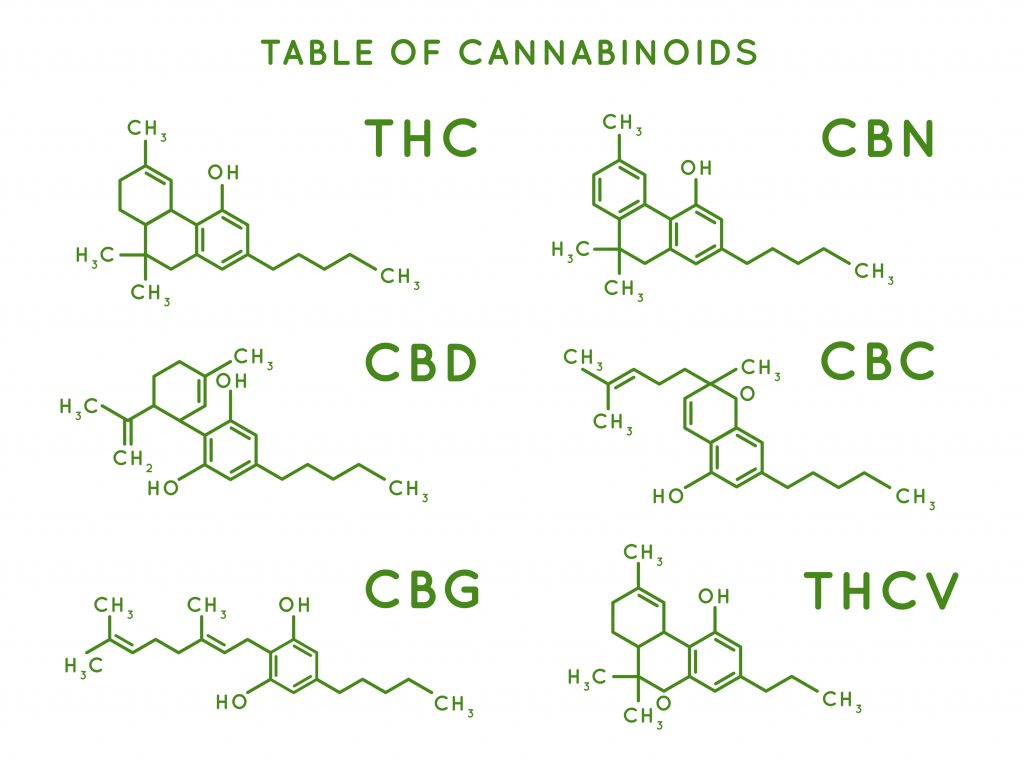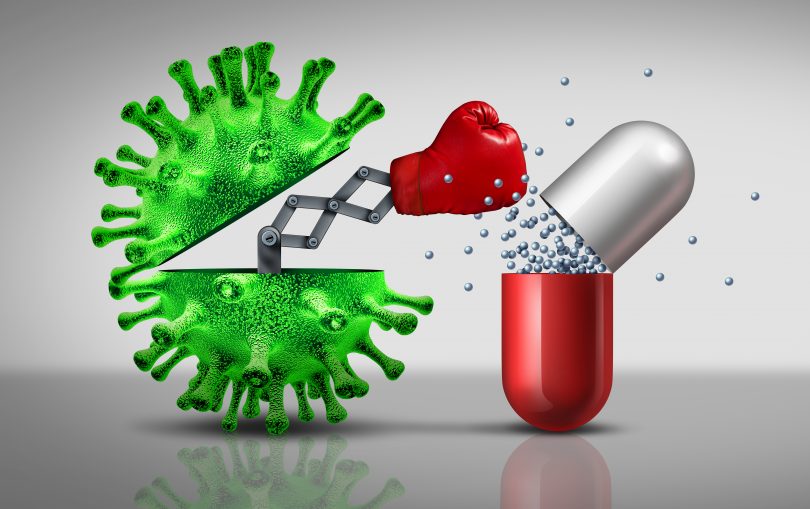Cannabis has been used for its antimicrobial properties for thousands of years, but only recently have these benefits surfaced in Western medicine. A recent study highlights previously unknown antimicrobial properties of cannabis.
While the study focuses on several cannabinoids, it brings out CBG as a cannabinoid to pay attention to in terms of its antibiotic abilities.
We’ve got all kinds of information for you on medicinal cannabis and the best products. Sign up to our newsletter to see what’s out there.
What is CBG?
CBG – cannabigerol – is a cannabinoid of the cannabis plant. Unlike it’s counterparts THC and CBD, it is found in only very small quantities, making up approximately 1% of a harvest-ready plant. Like CBD, and unlike THC, it doesn’t produce a psychoactive effect. CBG comes from its acidic precursor, CBGA. CBGA in turn is converted into cannabinoids like THCA – tetrahydrocannabinolic acid, CBDA – cannabidiolic acid, and CBCA – cannabichromenic acid. What is left of the CBGA converts to CBG through decarboxylation. This is why so little of the plant is made of CBG.
CBG has been cited already as an anti-cancer agent, and now adds antibiotic to its repertoire of uses.
Recent research
There has been an increasing amount of research into the medical benefits of CBD, and as that field has expanded, interest has been put on other cannabinoids like CBG. Now, a new study is out which backs up the idea that cannabinoids – CBG in particular – possess a strong antibacterial capability. This is especially important as the idea of antibiotic resistance has become an issue.
One of the big contenders when it comes to antibiotic resistance is MRSA, a type of Staphylococcus aureus which is resistant to the antibiotic methicillin, an antibiotic which was once used to treat the infection, but which is rarely used now because of resistance to its effects. In a study published earlier in 2020: Uncovering the Hidden Antibiotic Potential of Cannabis, different cannabinoids like CBG were shown to have an antibiotic effect on MRSA.
They also did something else interesting. They both showed an ability to inhibit biofilms from forming, as well as the ability to eliminate already formed biofilms. This has huge implications in the fight against antibiotic resistance.
What are biofilms?
Why is the idea of breaking through biofilms or keeping them from forming important? Because biofilms are one of the biggest culprits in the spread of disease, and the inability to stop it. Biofilms can occur inside the body, or on surfaces outside of it.

A biofilm is a “community of micro-organisms irreversibly attached to a surface and encased in an EPS (extracellular polymeric substance matrix), with increased resistance to host cellular and chemical responses.” While most often associated with bacteria, they are also associated with fungi, protists, and viruses as well.
In some ways, biofilms inside the body cause a bigger issue in that they can’t be killed as easily. Anything used internally has to be sustainable by the human body in general, and hard-to-kill microbes often require means that are quite toxic internally. Externally this is also an issue, however, harsher methods can be used. On the other hand, biofilms outside the human body that exist on surfaces, pose a much bigger threat in terms of disease transmission.
Essentially a biofilm is like a cellular form of plastic wrap, but stronger, and harder to break. It forms a barrier between the microbes and the environment around which allows growth without interference. Biofilms have a specific architecture and allow a supreme environment for intercellular communication.
“Biofilms may form on a wide variety of surfaces, including living tissues, indwelling medical devices, industrial or potable water system piping, or natural aquatic systems.” This can create havoc, especially in medical settings where there is interaction with many forms of disease, and particularly when the biofilms are formed around antibiotic-resistant bacteria.
MRSA
When it comes to antibiotic resistance, Staphylococcus aureus is a key player in that it very well shows how quickly bacteria can change according to the environment around it. It started becoming resistant to antibiotics starting with penicillin, and steadily made its way through the varied antibiotics that have been used ever since. The particular strain MRSA, which is resistant to the antibiotic Methicillin, has become ubiquitous, showing up all over the place in hospital settings, and spreading quickly among patients with little recourse.
c is a dangerous staphylococcal bacterial infection that can cause all kinds of issues from pneumonia, to skin and heart problems, bone infections and more. Even TSS, or Toxic Shock Syndrome, the infection associated with tampon use that can lead to death, is a result of toxins produced by Staphylococcus aureus.
Obviously, having this running rampant in a place with sick people is a recipe for further and continued disaster. To give an idea, in 2019 the CDC released a report stating that deaths due to antibiotic resistance had been underestimated, and that approximately 35,000 deaths occur each year in the US alone, out of 2.8 million yearly infections. That’s a lot of people dying because their medicine didn’t work.
Is cannabis a breakthrough with biofilms?
No, not at all. The idea of antimicrobial agents being found in plants is hardly new. Not only have different plants been used in this way for thousands of years, but studies have already been done into the power of different compounds like essential oils. This study from 2019 highlights the investigation into cinnamon, marjoram, and thyme essential oils with cinnamon and thyme showing the best inhibitory results.

Go back even further to 2012 and there’s a study specifically investigating how different essential oils effect Staphylococcus aureus biofilms. Yup, the exact thing being cited as a breakthrough with cannabis, was actually established with other plants at least eight years ago. What that study found is that cassia, red thyme and Peru balsam essential oils were best at eradicating Staphylococcus aureus biofilms, and more effective than certain antibiotics. While the authors of the study do indicate that red thyme and cassia have not been tested against MRSA biofilms, they do indicate that essential oils like tea tree, thyme, and peppermint have shown effectiveness against MRSA biofilms.
This is important when looking at the antibacterial properties of cannabis, because when looking at progress into issues like antibiotic resistance, looking at the whole picture is necessary. Similar antimicrobial properties to cannabis can be found in plenty of other places in the plant world, some with a much likely higher rate of efficacy than cannabis.
Back to CBG and cannabinoids
In July of 2020, a systematic review was released investigating the antimicrobial properties of cannabis. The conclusion was that several cannabinoids are effective against gram positive bacteria like MRSA, and offer a possibly better treatment option to antibiotics which are harsh on the body and can’t be used indefinitely. Gram positive has to do with the classification of bacteria into two component groups according to their cell walls, with gram positive having thinner walls which sometimes makes them more receptive to antibiotic agents that target cell walls. This is not true all the time, as we find with MRSA, and with eliminating biofilms. The review also pointed out that beyond cannabinoids, terpenes have been shown to have antimicrobial benefits as well.
Why doesn’t MRSA become resistant to cannabis?
When dealing with cannabis, or any other plant as an antibiotic, the question becomes, why would cannabis, (or another plant), be effective without causing the bacteria strain to become resistant to it? The answer is rather simple, antibiotics are created to mimic the activity of plants, but they’re much more basic compounds that can very easily (apparently) be understood by the microbe which then mutates to resist effects of these simple antibiotics.
Plant compounds on the other hand are far more complicated and harder for a microbe to understand and fight. Plants have secondary metabolites which complicate them biologically, introducing tannins, alkaloids, flavonoids, and terpenes, which have been found in research to have antimicrobial properties, as well as helping to create a more complicated microbe-proof structure.

In the long run, this tells us that as antibiotic resistance becomes more of a problem, the answer to it will likely not be in a new pharmaceutical breakthrough, but in digging through the nature around us for the cure.
Conclusion
The idea of plants being used for antibiotics, and as an affront to antibiotic resistance, isn’t new. Thousands of years of history tells us how useful plants are in fighting disease, and recent research into the antimicrobial properties of cannabis highlights the power of plants in the fight against antibiotic resistance.
For its part, cannabis has been coming out strong as a competitor against standard antibiotics, and as a possible answer to the resistance issue. With cannabinoids like CBG showing a strong antibiotic effect, there’s reason to believe that the future of antibiotics will be as simple as going back to nature.
And this means the idea of antibiotic resistance might not have to be as scary as its made out to be.
Thanks for stopping by CBDtesters.co, your best spot for all the latest news on medicinal cannabis. Sign up to our newsletter to keep up-to-date.
Resources
Synthetic Cannabinoids (Are they synthetic cannabinoids safe?)
The Endocannabinoid System Explained (Why Cannabis Is Good for Our Bodies)
Everything You Need To Know About CBD Isolate (a deep look into hemp extracts)
Cannabinoids 101 – Spotlight on CBN (Cannabinol)
Your Complete Guide to EU GMP-Certified CBD Isolate and Distillate – Spotlight on the regulated EU market
Everything You Need To Know About CBG Isolate
Newest Cannabinoid Powerhouse – CBC – What Can It Do for You?
What is DELTA 8 THC (FAQ: Great resource to learn about DELTA 8THC)
The CBD Flowers Weekly newsletter (your top resource for all things smokable hemp flowers)
The Medical Cannabis Weekly newsletter (International medical cannabis business report)
The Legal Landscape Of CBD Hemp Flower In Europe
The Delta 8 Weekly Newsletter (All you need to know about Delta 8 thc)Regulators Go After Smokable Hemp Flower – What Does The Future Hold?
The Complex Issue of Marijuana and Hemp Business and Legalization On Tribal Land
Government Assistance Options for U.S. Hemp Farmers Affected By COVID-19








thanks u so much to share this information.